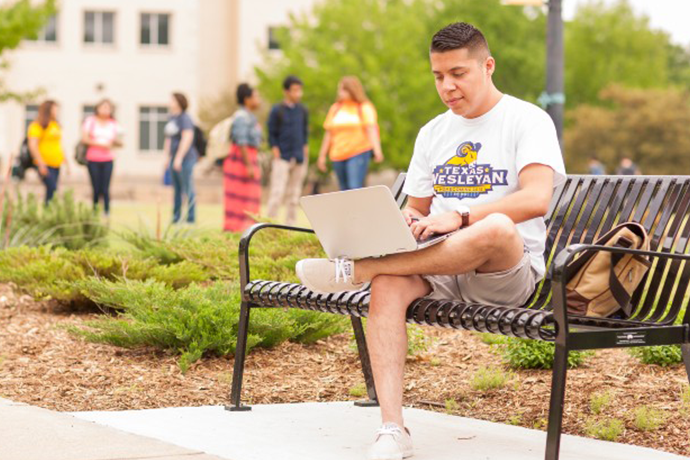How teachers are making their classes high tech

We turned to an expert on the cutting edge of classroom tech. Jacqueline Gaffner, Ed.D., is an associate professor of education at Texas Wesleyan whose expertise is incorporating technology into classrooms. Check out her tips and advice on how to improve the future of education using technology.
Today’s teachers are using more than just textbooks, flashcards and whiteboards to teach students. Technology is becoming a bigger part of lessons, which means today’s future teachers will need to have a sense of how to use it as a learning tool.
Want to learn even more? With a degree in undergraduate education from Texas Wesleyan, you'll work with expert professors and get set up for success as a teacher in the modern era.
Tip 1: Prepare for the future of digital learning
COVID-19 may have pushed us into the deep end of digital learning, but we learned how to swim. Educators have found winning solutions to help students thrive in this new digital age. But we have to remember that not all students have the technology experience or equipment needed to thrive in this space. We’re talking internet access, devices, training, support. Before putting any lesson into practice, make sure your students have the tech tools needed to get the most out of your teaching.
Tip 2: Engage your students with technology
Dr. Gaffner believes in a student-centered approach to teaching. It puts them in charge of their learning and allows them to actively engage with content. Teachers can enhance the student-learning experience by allowing students to use technology to create, collaborate and take control of their own learning.
Check out these 5 benefits of using technology to engage students and support instruction. You and your students will:
Be better collaborators
- Blogs and video discussions encourage collaboration among students
Learn to share with the world
- Sharing info online can expand a student’s experience beyond the classroom
Get instant evaluations
- Mobile devices can help teachers make quick use of apps that allow students to do quick assessments and provide feedback
Take learning on the go
- Don’t let your classroom walls limit your students’ learning. With today’s tech, there are plenty of online services your students can use to connect with your lesson plan from wherever they are.
Become content creators
- Ever feel like everyone has a podcast or vlog? You and your students could, too! Take your class into the spotlight by creating your own podcast. It’s a great way to share your creative assignments with a larger audience.
But before you jump in, make sure you’re training your students in how to be good digital citizens. This way, they are using their online tools responsibly and interacting with others safely and appropriately.
Common Sense Media has some great tips on how to teach digital citizenship.
Tip 3: Get familiar with technology
As a teacher, you’ll generally have access to devices such as:
- Interactive Whiteboards (SMART Boards, Promethean Boards, etc.),
- Document cameras
- Desktops, Chromebooks, iPads and laptops
Regardless of what tools you have handy, you should know how to use any device in a way that supports your students’ learning. That means any device, website, app or technology tool used for instruction should have an educational purpose that supports student learning.
Bonus: Get Google Certified
Here’s a bonus tip: your school district might use Google Classroom. It has plenty of learning tools for your students and is built for collaboration and access from anywhere.
Undergraduate education majors at Texas Wesleyan are taught how to use many different tools in Google, including Google Docs, Forms, Sheets, Drawings, etc. They graduate with the Google Certification Level 1 Exam — so they are ready to bring innovation into their classrooms.
Recommended tools for early childhood – grade 6 teachers
There are so many free educational apps out there. Districts also typically purchase site licenses for technology tools that teachers can use — so check with your IT department or regional service center to see what technology tools are available.
Here are some links to additional tech resources:
- Flipgrid - a free video discussion platform
- Padlet - an online bulletin board where you and your students can share work
- Nearpod - offers interactive slides, videos and activities providing you with instant student feedback
- PBS Kids Games - educational games for kids aged 2-8
- Seesaw - get ideas for activities and immediate feedback on students’ understanding
- ABCYa - educational games for kids from pre-k through 6th grade
- List from Common Sense Media - list of apps for preschool learning
- Plickers - interaction and instant feedback through educational card games
- Ditch That Textbook - blog featuring tips, tools and innovative teaching solutions
- Hyperdocs - digital lesson plans where students can access content and learning in one place
- Educational Technology and Mobile Learning - blog featuring the latest educational web tools and mobile apps
Want to learn more?
These cutting-edge techniques are just a part of what the next generation of teachers are learning from expert educators, like Dr. Gaffner, at Texas Wesleyan. Looking for small classes and one-on-one attention that will prepare you to change students’ lives on day one? Apply now to experience our Smaller. Smarter. program for yourself.








